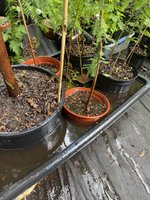Want a wide flare at the point the roots join the trunk? (Nebari) The principal to developing a spreading nebari is the same whether you are growing elms, maples, pines or bald cypress.
SHALLOW POTS - except for cascade and semi-cascade pots, all other bonsai pots are shallow, for USA people, less than 3 inches interior depth (less than 7.5 cm interior depth) if you want a seamless transition from "in-training" to bonsai pots, train all your young material in shallow containers less than 7.5 cm in depth. (3 inches). Only the largest bonsai pots are over 10 cm interior depth (4 inches). Cascade and semi-cascade pots are a different story, and not a possibility with bald cypress.
Bald cypress have an upright growth habit, cascading styles are not possible long term. Slanting is possible as long as the slant is above horizontal. The horticulture of Bald Cypress, trunks will not persist (live) long term with below horizontal trunk styles.
So given commercially available bonsai pots are shallow, there is wisdom in raising young, seedling and collected, and nursery bald cypress in shallow trays. Deep nursery pots simply make later adjustments to the tree more difficult. Flats, filled to less than 10 cm of soil (less than 4 inches of soil) will keep the root system confined to a narrow elevation. Wide flats that hold 5 gallons or more of potting media (20 liters or more) can allow trees to attain considerable trunk diameter with sun, ample water and fertilizer.
Flood or not to flood? Forestry papers suggest faster growth rates can be had without flooding.
@Mellow Mullet and others (including my personal experience) clearly have demonstrated adequate to "pretty darn good" growth can be had keeping trees flooded. Personal experience has shown that bald cypress will not "rebound" after a hard dry out. The shallow flats we use to develop are prone to drying out, so keeping them in trays of water can buy us (the growers) the extra time to get around to watering. Keeping bald cypress in standing water for the warmest months of the year is a very good option for growers that have to balance work and home life.
Bald cypress are botanically related to redwoods, and share with redwoods very fast growth rates when conditions are good. They appreciate warm summer weather. Those of us in the northernmost tier of states and provinces will not see the rapid growth that long warm summers will yield. They are distinct from redwoods, but they are closer to the redwoods than other groups of conifers. At a distance it is tricky to distinguish a Metasequoia from a bald cypress.
FWIW, There is evidence that some populations of Bald cypress in Texas (particularly Central Texas) don't produce knees--see "interesting facts" in the link below.
I don't know if that's true, but the above link is from Texas A&M, so go figure...I've also seen the same referenced in other places as possibly genetic.
I have a feeling that BC produce knees where there is high underground water table. Central Texas has a dome of underlying alkaline-ish coleche soil (which is fossilized sea shell) underneath topsoil that can inhibit such growth as well.
I have photos of bald cypress in my BNut profile media, available to forum members to view, there are photos from a canoe trip to visit a 1300 year old specimen on the Lower Cache River near Vienna IL. The knees belonging to that tree start nearly a quarter mile away from the tree. I also visited the Guadalupe River, near Braunfelds, TX, and the bald cypress lining the river there had no knees. This struck me as very odd. But indeed seemed widespread for the area. Whether is was the "caliche" or not, don't know. Under Vienna IL there is dolomitic limestone, so I am not sure the presence of limestone or not would cause knees or not. Perhaps the Guadalupe River population of BC has some hybrid gene introgression with Taxodium mucronatum. Note: hybrid gene introgression is NOT the same thing as a "simple" hybrid. It is a feature of a POPULATION of organisms. Its not (cat x dog) or (lion x tiger), For gene introgression the hybridization is implied or factually known (depending on organism) to have happened many generations previously. Subsequent crosses are between members of an interbreeding group, with a certain percentage of genes being from a species other than the nominate species. Majority of the traits will be of the nominate species. There will be a few "relict traits" of the past hybridizations.
So yes, I have seen bald cypress that do not produce knees, strange as that may be. I like 'em better with knees. But heck, that's personal tastes. Some like brunettes.
In pots, I am not certain I have seen "true knees" form. I have seen loops of roots, in fact I have folded surface roots myself, to get them to poke above the soil. In time these folded loops of roots look like knees, especially if a tight loop is done on a thin root. You can make fairly convincing "knees" by folding thin roots, with some practice. It also seems the roots will accidentally kink themselves to similar effect. I don't know if these are "true knees", I don't believe they are. But bonsai is all about appearance. If they look like knees in the display pot, it doesn't matter whether they are folded roots or "true knees". It is the appearance that counts.

